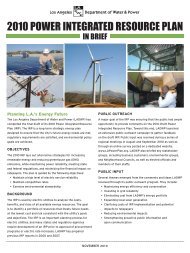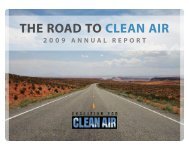TEN-YEAR CAPITAL IMPROVEMENT PROGRAM - LA Differentiated
TEN-YEAR CAPITAL IMPROVEMENT PROGRAM - LA Differentiated
TEN-YEAR CAPITAL IMPROVEMENT PROGRAM - LA Differentiated
You also want an ePaper? Increase the reach of your titles
YUMPU automatically turns print PDFs into web optimized ePapers that Google loves.
WATER SYSTEM OVERVIEW<br />
<strong>LA</strong>DWP delivers water to its customers<br />
through a complex and expansive<br />
network of large and small pipes, with<br />
varied functions, measuring more than<br />
7,200 miles in length. Trunk lines are<br />
pipes with a diameter greater than<br />
20 inches that transport water from<br />
wells and aqueducts to reservoirs and<br />
enable the movement of water from<br />
one area of the city to another. Trunk<br />
lines connect to smaller pipes known<br />
as distribution mains that supply water<br />
to the customer’s service connection.<br />
Water meters at the connection site<br />
then measure the customer’s water<br />
usage. <strong>LA</strong>DWP’s water distribution<br />
system is so extensive, that if all the<br />
pipes from trunk lines and distribution<br />
mains were laid end to end in a straight<br />
line, they would stretch from Los<br />
Angeles to New York and back again.<br />
Thirty years ago, 75% of L.A.’s water<br />
supply began as snowmelt on the<br />
slopes of the Eastern Sierra Nevada<br />
Mountains. An additional 15% of water<br />
came from local groundwater supplies<br />
and approximately 10% was purchased<br />
from Metropolitan Water District (MWD).<br />
However, today the city’s traditional<br />
water sources continue to change.<br />
As a result of several significant<br />
environmental restoration projects in<br />
the Owens Valley, <strong>LA</strong>DWP has reduced<br />
the amount of water delivered from the<br />
Eastern Sierra Nevada Mountains via<br />
the Los Angeles Aqueduct from 75%<br />
to approximately 35%. These projects<br />
include restoring Mono Lake, controlling<br />
dust pollution at Owens Dry Lake, and<br />
re-watering the Lower Owens River.<br />
In addition to a shrinking supply from<br />
the Eastern Sierra, L.A.’s growing water<br />
demand, and extended periods of<br />
drought have led <strong>LA</strong>DWP to augment<br />
its water supply by increasing its water<br />
purchases from MWD. Over the last<br />
several years, <strong>LA</strong>DWP has seen its<br />
annual average purchase of water from<br />
MWD increase from 15% to 53%, and its<br />
groundwater supply decrease from 15%<br />
to 11%. In an effort to supplement these<br />
sources, Los Angeles is increasing its use<br />
of recycled water – currently representing<br />
about 1% of the total water supply. The<br />
Water System is also moving aggressively<br />
to meet the city’s growing demand<br />
for water through increased water<br />
conservation, watershed management,<br />
groundwater banking, stormwater<br />
capture and water transfers.<br />
<strong>TEN</strong>-<strong>YEAR</strong> <strong>CAPITAL</strong> <strong>IMPROVEMENT</strong> <strong>PROGRAM</strong><br />
7





